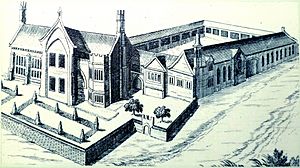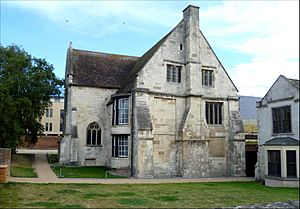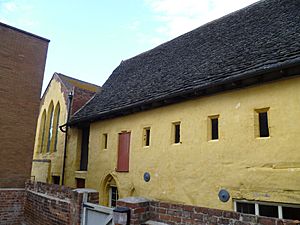Blackfriars, Gloucester facts for kids

Blackfriars in Gloucester, England, is a very old and well-preserved building. It was started around 1239. It used to be a home for a group of monks called the Dominican friars. They were known as "Blackfriars" because of their black cloaks.
Today, Blackfriars is owned by English Heritage. It was fixed up in 1960 and is now used for many things. You can find weddings, concerts, and exhibitions here. It's also used for tours, filming, and school events. The old church part of Blackfriars is now a house. It is a very important historic building, called a Grade I listed building.
Contents
History of Blackfriars
This special monastery was built west of Southgate Street. The city wall was right next to it on the south side. It had a church and a square courtyard. Around the courtyard were buildings like the scriptorium (a library for writing) and the dormitory. The dormitory had a famous roof with criss-cross wooden beams.
How Blackfriars Started
The friary was set up around 1239. King Henry III helped to support it. At its busiest time, about 30 to 40 friars lived there. They spent their lives studying, praying, and helping people.
Changes After the Monasteries Closed
In 1539, many monasteries in England were closed down. This was called the dissolution of the monasteries. Blackfriars was sold for £240 to a man named Thomas Bell. He was the Mayor of Gloucester.
Thomas Bell changed the church into his own home. He also turned the other buildings, like the old library, into a factory. He used it to make caps!
Bell Place: A New Home
By 1545, the church was a grand house. Thomas Bell called it "My howse called Bell Place" in his will. He made many changes to the building. He shortened the church and added new floors and stone windows. A round bay window was also added. A very large window in the north part of the church was replaced with smaller ones.
In 1555, a bishop named John Hooper died for his beliefs. His wife, Anne Hooper, and other clergy from Blackfriars had to leave England. Anne and her daughter, Rachel, sadly died in Frankfurt in 1555 from the plague. Anne left money to her son.
Later Years and Discoveries
In 1721, an artist named William Stukeley drew a picture of Blackfriars. This drawing helps us understand what the friary looked like back then.
In the 1930s, Bell Place was divided into two homes. The restoration work on the old church finished in 1984. After that, it was opened for people to visit.
The buildings around the courtyard were changed from a cap factory into homes in the 1700s. Part of the west side was made taller and became three houses. Thomas Bell left Blackfriars to his niece, Joan, and her husband, Thomas Denys. Their family owned it until about 1700.
The two old gates to Blackfriars are no longer there. One was removed before 1724, and the other fell down around 1750. One gate was known as Lady Bell's Gate. This name is remembered in the modern street name "Ladybellegate." The west side of the courtyard faces this street.
Today, Blackfriars is the most complete Dominican monastery left in Britain. It also has the oldest library in the country that was built just for books. The dormitory roof, with its unique criss-cross beams, is also very famous.




